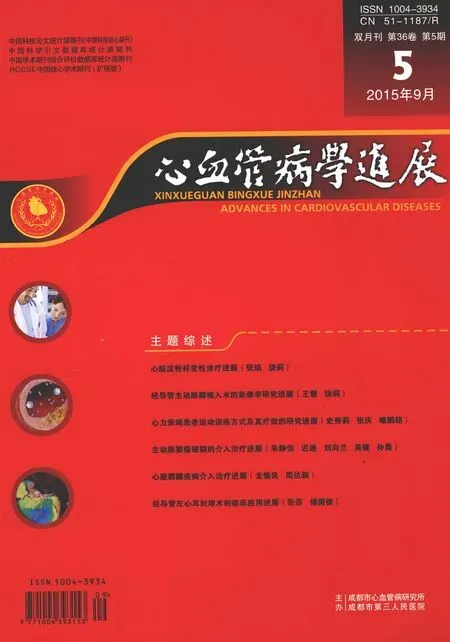脑啡肽酶抑制剂在缺血性心脏病中的研究进展
克丽比努尔·吾提库尔 综述 买苏木·买合木提 审校
(新疆医科大学第一附属医院心脏中心重症监护室,新疆乌鲁木齐 830054)
脑啡肽酶抑制剂在缺血性心脏病中的研究进展
克丽比努尔·吾提库尔 综述 买苏木·买合木提 审校
(新疆医科大学第一附属医院心脏中心重症监护室,新疆乌鲁木齐 830054)
脑啡肽酶是一个含锌离子的Ⅱ型膜蛋白金属内肽酶。近年来,大量实验研究显示脑啡肽酶抑制剂通过抑制脑啡肽酶的活性,发挥抑制利钠因子、改善血管内皮功能、抗动脉粥样硬化、抗心肌纤维化、延缓心肌重构、改善心肌缺血、改善心功能等作用。从实验室到临床应用转化的初期临床试验中观察到,脑啡肽酶抑制剂治疗缺血性心脏病的安全性好,可改善预后,其临床应用前景令人期待。
脑啡肽酶;脑啡肽酶抑制剂;缺血性心脏病
缺血性心脏病(ischemic heart disease)是由于冠状动脉狭窄和供血不足而引起的心肌机能障碍和/或器质性病变。有研究显示缺血性心脏疾病及其所致的心力衰竭病死率达30%,5年病死率高于肿瘤[1-2]。现阶段,治疗缺血性心脏病的主要方法包括药物保守治疗和手术治疗[3]。但是传统药物治疗效果有限,而介入治疗和心脏移植因技术、费用、风险、疗效、供体稀缺、伦理等问题限制了其在临床中的应用和发展[4]。越来越多的研究[5-7]发现脑啡肽酶抑制剂在治疗缺血性心脏病方面有着较传统药物(β受体阻滞剂、血管紧张素转换酶抑制剂)不可比拟的优势,或将成为治疗缺血性心脏病的新靶点。现就脑啡肽酶抑制剂在治疗缺血性心脏病中的作用以及其可能机制做一综述。
1 背景
脑啡肽酶分布于肺、肠、肾上腺、脑等,广泛存在于内皮细胞、血管平滑肌细胞、心肌细胞、肾脏上皮细胞和纤维母细胞中,并参与了各种内源性血管活性多肽的分解,包括血管紧张素Ⅱ、缓激肽、内皮素、利钠因子等[8]。脑啡肽酶抑制剂通过抑制脑啡肽酶的活性发挥重要的作用。许多研究[9-13]均证实脑啡肽酶抑制剂可以通过抑制利钠肽代谢、抑制血管紧张素Ⅱ、抑制内皮素、抑制缓激肽降解等可能机制治疗缺血性心脏病。
2 脑啡肽酶抑制剂治疗缺血性心脏病的作用及可能机制
2.1 抑制利钠因子
脑啡肽酶是通过分解心房利钠因子(atrial natriuretic peptide,ANP)、脑利钠因子(brain natriuretic peptide,BNP)和C型利钠因子等利钠因子家族而发挥作用的一种金属内肽酶[14]。研究证实[15]利钠因子通过扩张血管,排钠利尿,抑制心脏肥厚、抑制交感神经活动等作用改善心功能。研究表明,脑啡肽酶抑制剂通过抑制脑啡肽酶的活性减慢利钠因子的代谢,增加血浆中利钠因子、利钠因子第二信使环磷酸鸟苷的浓度从而更长时间和更大程度地发挥对心血管系统的有利作用[16]。
2.2 改善内皮功能
内皮功能障碍是发生血管疾病的重要特征,内皮损伤和/或功能障碍能促进动脉粥样硬化发生。C型利钠因子是一种较强的舒血管活性多肽,研究表明,C型利钠因子通过抑制纤溶酶原活化因子抑制剂-l(PAI-l,参与细胞外基质生成的因子)、减少巨噬细胞等的数量,从而改善动脉内皮功能。研究[17]表明抑制脑啡肽酶对内膜增生和炎症的有利效应是增加了C型利钠因子水平,从而减轻内皮损伤。另外,研究发现[18],在另一方面,脑啡肽酶抑制剂增加一氧化氮合成酶的表达,使一氧化氮升高,同时增加利钠肽水平,并使血管平滑肌对乙酰胆碱呈现舒张反应,从而抑制血管重构和改善血管内皮功能。
2.3 抗动脉粥样硬化
动脉粥样硬化一般是大多数缺血性慢性心脏病的主要并发原因。有研究报道脑啡肽酶抑制剂使动脉粥样硬化兔血浆环磷酸鸟苷明显增加,内皮素转换酶-1活性明显降低,动脉组织中内皮素-1含量减少,动脉粥样硬化病变明显减轻[19]。类似的研究证实:脑啡肽酶抑抑制剂使兔动脉粥样硬化斑块面积减少,主动脉胆固醇和胆固醇酯类含量降低,血浆总胆固醇下降27%,而防治动脉粥样硬化[20]。
2.4 抗心肌纤维化
心脏疾病重要病理变化之一是心肌纤维化,随着心肌纤维化的进展可以加重心肌缺血,从而引起心力衰竭、心律失常和甚至引起猝死。研究表明[21],利钠肽在一定病理条件下,在调节成纤维细胞生长中起重要的旁分泌作用;利尿钠肽作用于心肌细胞及心肌成纤维细胞A型利钠肽受体,使得细胞内环磷酸鸟苷水平升高,抑制心肌成纤维母细胞增生分化,抑制心肌纤维化。文献报道[22]脑啡肽酶抑制剂不仅能通过减少血管紧张素Ⅱ,增加利尿钠肽系统和缓激肽的表达,减少心脏成纤维细胞分泌胶原,而且还能通过减少表面黏附分子、核因子-κB、单核趋化蛋白的表达、心肌间质巨噬细胞的聚集来减轻心脏纤维化,从而改善心脏功能。
2.5 延缓心肌重构
研究发现[23],降低脑啡肽酶活性能抑制心肌肥厚和胶原沉积。胶原组织中含14%的羟脯氨酸,后者的含量能平行反映胶原组织增生的程度;心脏纤维原细胞中抑制脑啡肽酶的活性,能增强ANP诱导的羟脯氨酸的结合下降,减少胶原沉积。Mishima等[24]研究发现,早期、长期抑制脑啡肽酶可延缓左心室重构的进展。因此,除了临床上常用的血管紧张素转换酶抑制剂、β受体阻滞剂、抗醛固酮治疗外,抑制脑啡肽酶也有防治心肌重构的作用。
2.6 改善心肌缺血
缺血性心脏病患者的心肌缺血与患者发病率和病死率高密切相关。缓激肽在心肌缺血中发挥重要的心肌保护作用。Rashid等[25]发现缓激肽增加缺血部位心肌血流量, 从而减少心肌缺血的面积。而心脏中的脑啡肽酶参与将近一半的缓激肽的降解,肽酶抑制剂可使缓激肽失活延迟从而改善心肌缺血。研究表明[26],应用脑啡肽酶抑制剂后出现心肌再灌注损伤减少,改善心肌缺血状态,这些作用是缓激肽介导的。
2.7 改善心功能
心力衰竭是缺血性心脏疾病的终末阶段,具有较高的病死率。研究表明,在慢性充血性心力衰竭犬的研究中脑啡肽酶抑制剂增加血浆BNP含量、提高肾小球滤过率和尿钠分泌量、增加心排血量、降低心脏充盈压等[27]。Solomon等[28]指出,脑啡肽酶抑制剂增加心力衰竭患者射血分数,从而改善血流动力学。PARADIGM-HF等研究[29]报道脑啡肽酶抑制剂降低心力衰竭患者的病死率及住院天数,提高生活质量,进而改善心力衰竭患者的预后。
3 展望
综上所述,脑啡肽酶抑制剂通过改善血管内皮功能、抗动脉粥样硬化、改善心肌缺血、抗心肌纤维化、延缓心肌重构、改善心功能等作用治疗缺血性心脏病。尽管近期的大量研究正越来越深入地解析出脑啡肽酶抑制剂所能产生的作用,但是目前仍有一些问题没有得到解答,如脑啡肽酶抑制剂能否在缺血性心脏病患者中产生促进血管再生、改善微循环的作用?脑啡肽酶抑制剂能否减少缺血性心脏病的复发?脑啡肽酶抑制剂能否抑制缺血心肌细胞的程序性细胞死亡?这些问题仍需要大量的研究去加以论证。大量临床研究结果已经证实脑啡肽酶抑制剂治疗心肌缺血性心脏病的的安全性和有效性,期待着脑啡肽酶抑制剂为缺血性心脏病药物治疗开创一种新的途径。
[1] Lioyd-Jones D,Adams RJ,Brown TM,et al.Heart disease and stroke statistics—2010 update:a report from the American Heart Association[J].Circulation,2010,121(7):e46-e215.
[2] Bui AL,Horwich TB,Fonarow GC,et al.Epidemiology and risk profile of heart failure[J].Nat Rev Cardiol,2011,8(1):30-41.
[3] Xiao J,Chen CZ,Huang Z,et al.Discovery,optimization,and biological activity of the first potent and selective small-molecule agonist series of human relaxin receptor 1(RXFP1)[M].US National Center for Biotechnology Information,2013 .
[4] Lavu M, Gundewar S, Lefer DJ. Gene therapy for ischemic heart disease[J].J Mol Cell Cardiol,2011,50(5):742-750.
[5] von Lueder TG, Atar D,Krum H.Current role of neprilysin inhibitors in hypertension and heart failure[J].Pharmacol Ther,2014,144:41-49.
[6] Dalzell JR,Seed A,Berry C,et al.Effects of neutral endopeptidase (neprilysin) inhibition on the response to other vasoactive peptides in small human resistance arteries: studies with thiorphan and omapatrilat[J].Cardiovasc Ther,2014,32:13-18.
[7] Ng LL,Sandhu JK,Narayan H,et al.Proenkephalin and prognosis after acute myocardial infarction[J].J Am Coll Cardiol,2014,3:280-289.
[8] Standeven KF, Hess K,Carter AM,et al. Neprilysin,obesity and the metabolic syndrome[J].Int J Obes (Lond),2011,35:1031-1040.
[9] Kario K,Sun N,Chiang FT,et al.Efficacy and safety of LCZ696, a first-in-class angiotensin receptor neprilysin inhibitor, in Asian patients with hypertension: a randomized, double-blind, placebo-controlled study[J].Hypertension, 2014,63(4):698-705.
[10]Hu P,Xuan Q, Hu B,et al.Anti-neutral endopeptidase, natriuretic peptides disarrangement, and proteinuria onset in membranous nephropathy[J].Mol Biol Rep,2013,40(4):2963-2967.
[11]McMurray JJ, Packer M, Desai AS,et al.Angiotensin-neprilysin inhibition versus enalapril in heart failure[J].N Engl J Med,2014,371(11):993-1004.
[12]Braunwald E.The path to an angiotensin receptor antagonist-neprilysin inhibitor in the treatment of heart failure[J].J Am Coll Cardiol,2015,65(10):1029-1041.
[13]Packer M, McMurray JJ, Desai AS,et al.Angiotensin receptor neprilysin inhibition compared with enalapril on the risk of clinical progression in surviving patients with heart failure[J].Circulation, 2015,131(1):54-61.
[14]Mangiafico S ,Boerrigter LC,Andersen IA,et al.Neutral endopeptidase inhibition and the natriuretic peptide system:an evolving strategy in cardiovascular therapeutics[J].Eur Heart J,2013,34:886-893.
[15]Nakagawa H, Oberwinkler H, Nikolaev VO,et al. Atrial natriuretic peptide locally counteracts the deleterious effects of cardiomyocyte mineralocorticoid receptor activation[J].Circ Heart Fail,2014,7:814-821.
[16]Jessup M.Neprilysin inhibition—a novel therapy for heart failure[J]. N Engl J Med,2014,371(11):1062-1064.
[17]Oei HH,van der Meer IM,Hofman A,et al.Lipoprotein-associated phospholipase A2 activity is associated with risk of coronary heart disease and ischemic stroke:the Rotterdam Study[J].Circulation,2005,111(5):570-575.
[18]Kusaka H,Sueta D,Koibuchi N,et al.LCZ696,angiotensin Ⅱ receptor-neprilysin inhibitor,ameliorates high-salt-induced hypertension and cardiovascular injury more than valsartan alone[J].Am J Hypertens,2015,10:1-9.
[19]Schirger JA,Grantham JA,Kullo IJ,et al.Vascular actions of brain natriuretic peptide:modulation by atherosclerosis and neutral endopeptidase inhibitor[J].J Am Coll Cardiol,2005,35(3):798-801.
[20]Naruko T,Ueda M,Haze K,et al.Neutrophil infiltration of culprit lesions in acute coronary syndromes[J].Circulation,2002,106(23):2894-2900.
[21]Chopra S, Baby C, Jacob JJ. Neuro-endocrine regulation of blood pressure[J].Indian J Endocrinol Metab,2011,15(4):S281-S288.
[22]von Lueder TG, Sangaralingham SJ, Wang BH, et al. Renin-angiotensin blockade combined with natriuretic peptide system augmentation: novel therapeutic concepts to combat heart failure[J].Circ Heart Fail, 2013,6(3):594-605.
[23]Pham AQ,Patel Y,Gallagher B.LCZ696 (angiotensin-neprilysin inhibition):the new kid on the heart failure block?[J].J Pharm Pract,2015,28(2):137-145.
[24]Mishima T,Tanimura M,Suzuki G,et al.Effects of chronic neutral endopeptidase inhibition on the progression of left ventricular dogs—Function and remodeling in dogs with moderate heart failure[J].Cardiovasc Drugs Ther,2002,16(3):209-214.
[25]Rashid MH, Inoue M, Koudo S, et al. Novel expression of vanilloid receptor 1 on capsaicin-insensitive fibers accounts for the analgesic effect of capsaicin cream in neuropathic pain[J]. J Pharmacol Exp Ther,2003,304(3):940-948.
[26]Zhang X,Nasjletti A,Xu X,et al.Neutral endopeptide and angiotensin-converting enzyme inhibitors increase nitric oxide production in isolated canine coronary microvessels by a kinin-dependent mechanism[J].J Cardiovasc Pharmacol,2008,21(4):623-629.
[27]Ito S,Satoh M,Tamaki Y,et al.Safety and efficacy of LCZ696, a first-in-class angiotensin receptor neprilysin inhibitor, in Japanese patients with hypertension and renal dysfunction[J].Hypertens Res,2015,38(4):269-275.
[28]Solomon SD, Zile M, Pieske B,et al. The angiotensin receptor neprilysin inhibitor LCZ696 in heart failure with preserved ejection fraction: a phase 2 double-blind randomized controlled trial[J].Lancet,2012,380:1387-1395.
[29]McMurray JJ,Packer M,Desai AS,et al.Angiotensin-neprilysin inhibition versus enalapril in heart failure[J].N Engl J Med,2014,371:993-1004.
Neprilysin Inhibitors Progress in Ischemic Heart Disease Study
KELIBINUER·Wutikuer, MAISUMU·Maihemuti
(Department of Coronary Care Unit,The First Affiliated Hospital of Xinjiang Medical University,Urumqi 830054,Xinjiang,China)
Neprilysin is type Ⅱ integral membrane metallopeptidase which is zinc-dependent. Recently research has found that neprilysin inhibitors acts by inhibiting the activity of neprilysin through various ways,for example,inhibit natriuretic peptides,improves endothelial function,anti-atherosclerosis,myocardial ischemia,anti-myocardial fibrosis,heart function,and delays myocardial remodelling. Treatment of ischemic heart disease with neprilysin inhibitors is well tolerated and has been proven safe from experiment to clinical trials and improves prognosis.
neprilysin;neprilysin inhibitors;ischemic heart disease
国家自然科学基金(81360043)
克丽比努尔·吾提库尔(1989—),在读硕士,主要从事心力衰竭研究。Email:1970257437@qq.com
买苏木·买合木提,主任医师,主要从事心力衰竭研究。Email:morningsun654321@126.com
R
A
10.3969/j.issn.1004-3934.2015.05.019
2015-02-03
2015-05-14

